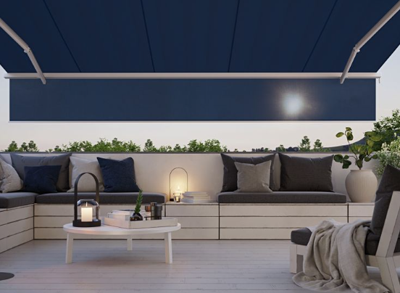
Adding a weatherproof awning can completely change the way you use your outdoor space, and I'm talking about a real transformation. Whether it's a patio, porch, or backyard area, the right awning offers serious protection from sun, rain, and wind, turning your exterior into a comfortable, usable extension of your home.
But before you buy, it's important to understand your options because there are a lot of them. Not all weatherproof awnings are the same, and factors like material, design, installation requirements, and durability can make a huge difference in long-term satisfaction.
Here's what to look for, how to choose the right model for your situation, and what to expect before and after installation.
What Actually Makes an Awning "Weatherproof"?
A weatherproof awning is designed to withstand way more than just light sun exposure. The term gets thrown around a lot, but there are specific features that actually make the difference.
Key features typically include UV-resistant fabric or solid panels that won't fade or crack, water-repellent or completely waterproof materials that shed rain instead of absorbing it, strong frames that can handle significant wind loads without bending or breaking, and optional snow-resistance for four-season models if you live somewhere with winter weather.
Look for actual certifications or detailed specs around wind ratings and waterproofing levels to confirm real durability, not just marketing language that sounds impressive but doesn't mean much.
Different Types of Weatherproof Awnings
You'll encounter two main categories when shopping around. Retractable awnings can be manual or motorized and are great for flexibility and space-saving when you don't always want coverage. Fixed or permanent awnings are generally more durable and ideal for areas that need consistent protection.
Material types vary significantly too. Fabric options like acrylic or vinyl-coated polyester offer style and flexibility with lots of color choices. Solid panels made from polycarbonate or aluminum provide maximum long-term protection but with less style variety.
Match the type to your climate, how you plan to use the space, and your style preferences. There's no one-size-fits-all solution, so think about your specific needs.
Key Factors to Consider Before You Buy
Before making any decisions, take an honest look at your local weather patterns. Do you deal with strong sun most of the year? Frequent rain? Heavy snow that could damage a lightweight awning?
Consider your mounting surface too. Is it wood siding, brick, or something else? This affects installation complexity and cost. Think about the size and coverage area you actually need, your total budget including potential installation costs, and maintenance needs plus expected lifespan.
Also decide if you want extras like integrated lighting for evening use, side panels for privacy, or wind sensors on retractable models that automatically retract during storms. These features add cost but can be worth it.
Common Mistakes That Cost Money
Many homeowners end up regretting their purchase because they made predictable mistakes. Choosing a fabric that fades quickly or sags after one season is a big one. Buying a cheap model that can't actually handle normal wind conditions is another costly error.
Skipping professional installation when it's really needed often leads to problems down the road. Not measuring accurately or failing to check slope requirements for proper drainage can cause water pooling and damage.
Don't rely on looks alone when making your decision. Check actual product specifications, warranty details, and real user reviews from people who've had the awning for a while, not just initial impressions.
Installation and Long-Term Care
Some basic DIY models are pretty simple to install if you're handy with tools, but heavy-duty weatherproof awnings often require professional installation, especially if you're tying into a roofline or complex structure.
Once your awning is installed, you'll need to maintain it properly. Clean it regularly, especially after storms or heavy pollen seasons. Check for rust, tears, or loose bolts every few months to catch problems early.
If you have a retractable model, make sure to retract it during extreme weather conditions even if it's rated for wind. No awning is indestructible, and proper care extends the lifespan significantly.
Think Long-Term, Not Just Initial Cost
Remember that a weatherproof awning should last for years, so don't base your decision solely on the cheapest upfront price. Factor in durability, warranty coverage, and how much you'll actually use the protected space.
A slightly more expensive awning that lasts twice as long is usually the better deal when you do the math. Plus, you won't have the hassle and expense of replacement in just a few years.
Make a Decision You Won't Regret
Buying a weatherproof awning isn't just a style decision, it's a long-term investment in comfort, protection, and functionality for your home. By honestly understanding your climate, material options, and usage needs, you can confidently choose an awning that fits your home and actually holds up to the elements.
Take the time to research properly, measure everything twice, and plan for professional installation if needed. You'll end up enjoying a more comfortable, protected outdoor space no matter what the weather throws at you.




(0) comments
We welcome your comments
Log In
Post a comment as Guest
Keep it Clean. Please avoid obscene, vulgar, lewd, racist or sexually-oriented language.
PLEASE TURN OFF YOUR CAPS LOCK.
Don't Threaten. Threats of harming another person will not be tolerated.
Be Truthful. Don't knowingly lie about anyone or anything.
Be Nice. No racism, sexism or any sort of -ism that is degrading to another person.
Be Proactive. Use the 'Report' link on each comment to let us know of abusive posts.
Share with Us. We'd love to hear eyewitness accounts, the history behind an article.